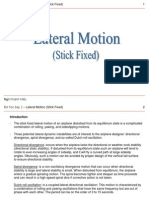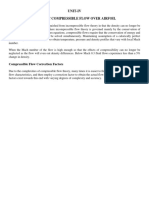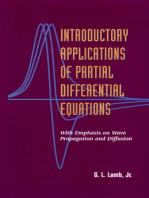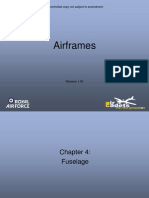3241 Lecture 8
3241 Lecture 8
Uploaded by
Jamal AlshaweshCopyright:
Available Formats
3241 Lecture 8
3241 Lecture 8
Uploaded by
Jamal AlshaweshOriginal Description:
Copyright
Available Formats
Share this document
Did you find this document useful?
Is this content inappropriate?
Copyright:
Available Formats
3241 Lecture 8
3241 Lecture 8
Uploaded by
Jamal AlshaweshCopyright:
Available Formats
MAE 3241: AERODYNAMICS AND FLIGHT MECHANICS
REVIEW OF INCOMPRESSIBLE FLOW
OVER AIRFOILS AND WINGS
Mechanical and Aerospace Engineering Department
Florida Institute of Technology
D. R. Kirk
HOW DOES AN AIRFOIL GENERATE LIFT?
Lift due to imbalance of pressure distribution over top and bottom surfaces of
airfoil (or wing)
If pressure on top is lower than pressure on bottom surface, lift is generated
Why is pressure lower on top surface?
We can understand answer from basic physics:
Continuity (Mass Conservation)
Newtons 2
nd
law (Euler or Bernoulli Equation)
Lift = PA
HOW DOES AN AIRFOIL GENERATE LIFT?
1. Flow velocity over top of airfoil is faster than over bottom surface
Streamtube A senses upper portion of airfoil as an obstruction
Streamtube A is squashed to smaller cross-sectional area
Mass continuity rAV=constant: IF A THEN V
Streamtube A is squashed
most in nose region
(ahead of maximum thickness)
A
B
HOW DOES AN AIRFOIL GENERATE LIFT?
2. As V p
Incompressible: Bernoullis Equation
Compressible: Eulers Equation
Called Bernoulli Effect
3. With lower pressure over upper surface and higher pressure over bottom surface,
airfoil feels a net force in upward direction Lift
VdV dp
V p
r
r
constant
2
1
2
Most of lift is produced
in first 20-30% of wing
(just downstream of leading edge)
AIRFOILS VERSUS WINGS
Why do airfoils have such a shape?
How are lift and drag produced?
NACA airfoil performance data
How do we design?
What is limit of behavior?
FINAL EXAM SAMPLE QUESTIONS
Tell me everything can you about the design of these wings
d
dihedral
AIRFOIL NOMENCLATURE
Mean Chamber Line: Set of points halfway between upper and lower surfaces
Measured perpendicular to mean chamber line itself
Leading Edge: Most forward point of mean chamber line
Trailing Edge: Most reward point of mean chamber line
Chord Line: Straight line connecting the leading and trailing edges
Chord, c: Distance along the chord line from leading to trailing edge
Chamber: Maximum distance between mean chamber line and chord line
Measured perpendicular to chord line
NACA AIRFOIL NAMING CONVENTION
NACA (National Advisory Committee for Aeronautics) precursor to NASA
Excellent historical discussion in Section 2.8
Early NACA series, 4-, 5-, modified 4-/5-digit generated with analytical equations
Later families, including 6-Series, are more complicated shapes derived using
theoretical rather than geometrical methods
Before NACA series, airfoil design was rather arbitrary with nothing to guide
designers except experience with known shapes and experimentation with
modified shapes
EXAMPLE: NACA FOUR-DIGIT SERIES
First digit specifies maximum camber in percentage of chord
Second digit indicates position of maximum camber in tenths of chord
Last two digits provide maximum thickness of airfoil in percentage of chord
Example: NACA 2415
Airfoil has maximum thickness of 15%
of chord (0.15c)
Camber of 2% (0.02c) located 40%
back from airfoil leading edge (0.4c)
NACA 2415
WHAT CREATES AERODYNAMIC FORCES? (2.2)
Aerodynamic forces exerted by airflow comes from only 2 sources
1. Pressure, p, distribution on surface
Acts normal to surface
2. Shear stress, t
w
, (friction) on surface
Acts tangentially to surface
Pressure and shear are in units of force per unit area (N/m
2
)
Net unbalance creates an aerodynamic force
No matter how complex the flow field, and no matter how complex the shape of
the body, the only way nature has of communicating an aerodynamic force to a
solid object or surface is through the pressure and shear stress distributions that
exist on the surface.
The pressure and shear stress distributions are the two hands of nature that
reach out and grab the body, exerting a force on the body the aerodynamic
force
RESOLVING THE AERODYNAMIC FORCE: WING
Relative Wind: Direction of V
We used subscript to indicate far upstream conditions
Angle of Attack, a: Angle between relative wind (V
) and chord line
Total aerodynamic force, R, can be resolved into two force components
Lift, L: Component of aerodynamic force perpendicular to relative wind
Drag, D: Component of aerodynamic force parallel to relative wind
RESOLVING THE AERODYNAMIC FORCE: ROCKET
Aerodynamic force, R, may also be resolved into components perpendicular and
parallel to chord line
Normal Force, N: Perpendicular to chord line
Axial Force, A: Parallel to chord line
L and D are easily related to N and A
For airfoils and wings, L and D most common
For rockets, missiles, bullets, etc. N and A more useful
a a
a a
cos sin
sin cos
A N D
A N L
MORE DEFINITIONS
Total aerodynamic force on airfoil is summation of F
1
and F
2
Lift is obtained when F
2
> F
1
Misalignment of F
1
and F
2
creates Moments, M, which tend to rotate airfoil/wing
A moment (torque) is a force times a distance
Value of induced moment depends on point about which moments are taken
Moments about leading edge, M
LE
, or quarter-chord point, c/4, M
c/4
In general M
LE
M
c/4
VARIATION OF L, D, AND M WITH a
Lift, Drag and M on a airfoil or wing will change as a changes
Variations of these quantities are some of most important information that an
airplane designer needs to know
Aerodynamic Center
Point about which moments essentially do not vary with a
M
ac
=constant (independent of a)
For low speed airfoils aerodynamic center is near quarter-chord point
SAMPLE DATA: SYMMETRIC AIRFOIL
L
i
f
t
C
o
e
f
f
i
c
i
e
n
t
Angle of Attack, a
A symmetric airfoil generates zero lift at zero a
SAMPLE DATA: CAMBERED AIRFOIL
L
i
f
t
C
o
e
f
f
i
c
i
e
n
t
Angle of Attack, a
A cambered airfoil generates positive lift at zero a
WHY DOES LIFT CURVE BEND OVER?
http://www.soton.ac.uk/Racing/Greenpower/BoundaryLayers/
Low a
Moderate a
High a
a
a
a
REAL EFFECTS: VISCOSITY (m)
To understand drag and actual airfoil/wing behavior we need an understanding of
viscous flows (all real flows have friction)
Inviscid (frictionless) flow around a body will result in zero drag!
Called dAlemberts paradox
Must include friction (viscosity, m) in theory
See 3.18-3.20
Flow adheres to surface because of friction between gas and solid boundary
At surface flow velocity is zero, called No-Slip Condition
Thin region of retarded flow in vicinity of surface, called a Boundary Layer
At outer edge of B.L., V
At solid boundary, V=0
The presence of friction in the flow causes a shear stress at the surface of a body,
which, in turn contributes to the aerodynamic drag of the body: skin friction drag
COMMENTS ON VISCOUS FLOWS
TYPES OF FLOWS: FRICTION VS. NO-FRICTION
Flow very close to surface of airfoil is
Influenced by friction and is viscous
(boundary layer flow)
Stall (separation) is a viscous phenomena
Flow away from airfoil is not influenced
by friction and is wholly inviscid
THE REYNOLDS NUMBER, Re
One of most important dimensionless numbers in fluid mechanics/ aerodynamics
Reynolds number is ratio of two forces:
Inertial Forces
Viscous Forces
c is length scale (chord)
Reynolds number tells you when viscous forces are important and when viscosity
may be neglected
m
r c V
Re
Within B.L. flow
highly viscous
(low Re)
Outside B.L. flow
Inviscid (high Re)
LAMINAR VERSUS TURBULENT FLOW
Two types of viscous flows
Laminar: streamlines are smooth and regular and a
fluid element moves smoothly along a streamline
Turbulent: streamlines break up and fluid elements
move in a random, irregular, and chaotic fashion
LAMINAR VERSUS TURBULENT FLOW
All B.L.s transition from
laminar to turbulent
c
f,turb
> c
f,lam
Turbulent velocity
profiles are fuller
FLOW SEPARATION
Key to understanding: Friction causes flow separation within boundary layer
Separation then creates another form of drag called pressure drag due to separation
COMPARISON OF DRAG FORCES
d
d
Same total drag as airfoil
OVERVIEW: AIRFOIL STALL
Key to understanding: Friction causes flow separation within boundary layer
1. B.L. either laminar or turbulent
2. All laminar B.L. turbulent B.L.
3. Turbulent B.L. fuller than laminar B.L., more resistant to separation
Separation creates another form of drag called pressure drag due to separation
Dramatic loss of lift and increase in drag
WHY DOES BOUNDARY LAYER SEPARATE?
Adverse pressure gradient interacting with velocity profile through B.L.
High speed flow near upper edge of B.L. has enough speed to keep moving
through adverse pressure gradient
Lower speed fluid (which has been retarded by friction) is exposed to same
adverse pressure gradient is stopped and direction of flow can be reversed
This reversal of flow direction causes flow to separate
Turbulent B.L. more resistance to flow separation than laminar B.L. because of
fuller velocity profile
To help prevent flow separation we desire a turbulent B.L.
WHY DOES AN AIRFOIL STALL?
Two major consequences of separated flow over airfoil
Dramatic loss of lift (stalling)
Separated flow causes higher pressure on upper surface of airfoil
Major increase in drag
Separation causes lower pressure on trailing edge
Unbalance of pressure force causes pressure drag due to separation
SAMPLE DATA: CAMBERED AIRFOIL STALL
L
i
f
t
o
r
L
i
f
t
C
o
e
f
f
i
c
i
e
n
t
Angle of Attack, a
SUMMARY OF VISCOUS EFFECTS ON DRAG
Friction has two effects:
1. Skin friction due to shear stress at wall
2. Pressure drag due to flow separation
pressure friction
D D D
Total drag due to
viscous effects
Called Profile Drag
Drag due to
skin friction
Drag due to
separation
= +
Less for laminar
More for turbulent
More for laminar
Less for turbulent
So how do you design?
Depends on case by case basis, no definitive answer
LIFT, DRAG, AND MOMENT COEFFICIENTS
Behavior of L, D, and M depend on a, but also on velocity and altitude
V
, r
, Wing Area (S), Wing Shape, m
, compressibility
Characterize behavior of L, D, M with coefficients (c
l
, c
d
, c
m
)
Re , ,
2
1
2
1
2
2
M f c
S q
L
S V
L
c
Sc V L
l
l
l
a
r
r
Matching Mach and Reynolds
(called similarity parameters)
M
, Re
M
, Re
c
l
, c
d
, c
m
identical
LIFT, DRAG, AND MOMENT COEFFICIENTS
Behavior of L, D, and M depend on a, but also on velocity and altitude
V
, r
, Wing Area (S), Wing Shape, m
, compressibility
Characterize behavior of L, D, M with coefficients (c
l
, c
d
, c
m
)
Re , ,
2
1
2
1
3
2
2
M f c
Sc q
L
Sc V
M
c
Scc V M
m
m
m
a
r
r
Re , ,
2
1
2
1
2
2
2
M f c
S q
D
S V
D
c
Sc V D
d
d
d
a
r
r
Re , ,
2
1
2
1
1
2
2
M f c
S q
L
S V
L
c
Sc V L
l
l
l
a
r
r
Comment on Notation:
Lower case, c
l
, c
d
, and c
m
for infinite wings (airfoils)
Upper case, C
L
, C
D
, and C
M
for finite wings (real wings)
SAMPLE DATA: NACA 23012 AIRFOIL
Lift Coefficient
c
l
=L/(rV
2
S)
Moment Coefficient
c
m, c/4
a
AIRFOIL DATA: NACA 23012 WING SECTION
c
l
c
m
,
c
/
4
Re dependence at high a
Separation and Stall
a
c
l
c
d
c
m
,
a
.
c
.
c
l
vs. a
Independent of Re
c
d
vs. a
Dependent on Re
c
m,a.c.
vs. c
l
very flat
AIRFOIL THICKNESS: WWI AIRPLANES
English Sopwith Camel
German Fokker Dr-1
Higher maximum C
L
Internal wing structure
Higher rates of climb
Improved maneuverability
Thin wing, lower maximum C
L
Bracing wires required high drag
EXAMPLE: F-104 LOCKHEED STARFIGHTER
First airplane designed for sustained flight at Mach 2
Very sharp leading edge on wings (razor sharp leading edges, thickness 3.4 %)
Designed to minimize wave drag at supersonic speeds
Very poor low-speed aerodynamic performance
Such wings tend to stall at low angles of attack, C
Lmax
is only about 1.15
V
stall
(full) ~ 198 MPH, V
stall
(empty) ~ 152 MPH (V
stall
proportional to W
1/2
)
EXAMPLE: BOEING 727
Designed in 1960s to operate out of airports with relatively short runways
Desire to minimize take-off and landing distances
Maximum C
L
= 3.0
V
stall
~ 113 MPH
OVERVIEW: KUTTA CONDITION
Suppose we model the flow around an airfoil using a potential flow approach:
How many theoretical potential flow solutions are exist?
The answer is that there are infinitely many.
Flow (1) and Flow (2) satisfy all conditions for potential flow theory, however G
1
G
2
, so we know that L
1
L
2
(recall rotating cylinder example)
Experimental evidence (nature) tells us which G should be used Kutta Condition
(see 4.5)
Flow 1 Flow 2
EXAMPLE: NACA 65-006 SYMMETRIC AIRFOIL
Bell X-1 used NACA 65-006
(6% thickness) as horizontal tail
Thin airfoil theory lift slope:
dc
l
/da = 2p rad
-1
= 0.11 deg
-1
Compare with data
At a = -4: c
l
~ -0.45
At a = 6: c
l
~ 0.65
dc
l
/da = 0.11 deg
-1
Thin airfoil theory:
c
m,c/4
= 0
Compare with data
dc
l
/da = 2p
c
m,c/4
= 0
CAN AN AIRFOIL PRODUCE LIFT WHEN IT IS FLYING UPSIDE DOWN?
NACA 2415 flying right side up
Zero angle of attack
Lift in positive vertical direction
NACA 2415 upside down
Zero angle of attack
Lift in negative vertical direction
Positive angle of attack
Say a=10
Lift in positive vertical direction
Positive angle of attack
Say a=10
Lift in positive vertical direction, but less
than the right side up airfoil
a
a
CAN AN AIRFOIL PRODUCE LIFT WHEN IT IS FLYING UPSIDE DOWN?
NACA 2415 flying upside down at certain angles of attack will generate positive
lift, but less than same airfoil right side up at the same angle of attack
Here is a way to understand this:
If we take airfoil on left and turn it upside down it is same as airfoil right side
up but with a negative angle of attack
Therefore, lift coefficient for upside down airfoil at positive angle of attack is
given by data for negative angles of attack
The negative cl connotes a downward lift on the ordinary right side up airfoil
when pitched to a negative angle of attack
In upside down orientation (airfoil on right), lift is directed upward
a
a
CAN AN AIRFOIL PRODUCE LIFT WHEN IT IS FLYING UPSIDE DOWN?
NACA 2415 AIRFOIL
Zero-lift a, a
L=0
= -2
So airfoil will generate positive
lift (when right side up) for a > -
2
Now turn airfoil upside down
If a = 0, negative lift
If a = 2, zero lift
If a is greater than 2 (but
reading a range) airfoil will
generate lift in positive vertical
direction
Upside down airfoil at same a
generates less lift
Example:
Right side up: a = 10, c
l
= 1.2
Upside down: a = 10, c
l
= - 0.8
VORTEX MOVING BLADE ROW MODEL
Thrust of engine largely
dependent on change in
total pressure across blade rows
Blade row interaction critical to
overall performance
D
e
t
a
i
l
o
f
m
u
l
t
i
p
l
e
c
o
m
p
r
e
s
s
o
r
r
o
w
s
FLIGHT MECHANICS EXAMPLE: GOSSAMER CONDOR
August 26, 1977: Gossamer Condor, designed by Dr. Paul MacCready (Caltech
graduate) in United States and piloted by racing cyclist Bryan Allen, wins 50,000
Kremer prize for first 1 mile figure-of-eight flight by a human-powered aircraft
Wingspan, b ~ 29 m, average chord, c ~ 2.3 m, total mass ~ 95 kg, C
D
~ 0.05
Pilot delivered HP to propel aircraft
For cruise at sea-level, estimate:
1. Cruise speed attained
2. C
L
3. HP required input by pilot to achieve a speed of 20 MPH
You might also like
- Cessna 340A - Cessna 340A Reference Manual - Rev 0 PDF100% (7)Cessna 340A - Cessna 340A Reference Manual - Rev 0 PDF367 pages
- Mae 3241: Aerodynamics and Flight Mechanics: Finite Wings: General Lift Distribution SummaryNo ratings yetMae 3241: Aerodynamics and Flight Mechanics: Finite Wings: General Lift Distribution Summary21 pages
- Bài 5 - Lateral Motion (Stick Fixed) (2008)No ratings yetBài 5 - Lateral Motion (Stick Fixed) (2008)12 pages
- Subsonic Compressible Flow Over AirfoilNo ratings yetSubsonic Compressible Flow Over Airfoil34 pages
- Ae 17412 - Aerodynamics Lab - I (Manual)No ratings yetAe 17412 - Aerodynamics Lab - I (Manual)50 pages
- Luftwaffe - Secret Designs of The Third Reich PDF100% (10)Luftwaffe - Secret Designs of The Third Reich PDF132 pages
- MSN 0700 Repair and Dent Status DEC-2018No ratings yetMSN 0700 Repair and Dent Status DEC-201863 pages
- 4-Lecture Notes Aerodynamics Introductory Lecture100% (2)4-Lecture Notes Aerodynamics Introductory Lecture30 pages
- Fluid Mechanics in Channel, Pipe and Aerodynamic Design Geometries 2From EverandFluid Mechanics in Channel, Pipe and Aerodynamic Design Geometries 2No ratings yet
- AED 312 Aerodynamics Questions - Ver1-1No ratings yetAED 312 Aerodynamics Questions - Ver1-138 pages
- CFD Analysis of Pressure Coefficient For NACA 4412No ratings yetCFD Analysis of Pressure Coefficient For NACA 44123 pages
- Practical Aspects of Dynamic SimilarityNo ratings yetPractical Aspects of Dynamic Similarity18 pages
- CH 6 Differential Analysis of Fluid Flow Part IINo ratings yetCH 6 Differential Analysis of Fluid Flow Part II100 pages
- Surface Pressure Distribution Over A CylinderNo ratings yetSurface Pressure Distribution Over A Cylinder5 pages
- CFD Modelling and Analysis of Clark Y Airfoil For Turbulent FlowNo ratings yetCFD Modelling and Analysis of Clark Y Airfoil For Turbulent Flow4 pages
- Objective Type Questions Instrumentation System & Devices (IDS)No ratings yetObjective Type Questions Instrumentation System & Devices (IDS)7 pages
- Wake Velocity Measurement For Flow Over A CylinderNo ratings yetWake Velocity Measurement For Flow Over A Cylinder3 pages
- Chapter 9 Oblique Shock And Expansion Waves 斜激波和膨胀波 9.1 引言No ratings yetChapter 9 Oblique Shock And Expansion Waves 斜激波和膨胀波 9.1 引言156 pages
- Aerospace Propulsion Dept of ANE, MRCET: 2.1:euler's Turbo-Machinery EquationsNo ratings yetAerospace Propulsion Dept of ANE, MRCET: 2.1:euler's Turbo-Machinery Equations31 pages
- Aerodynamics: BS Mechanical Engineering 8 SemesterNo ratings yetAerodynamics: BS Mechanical Engineering 8 Semester74 pages
- Assignments in Amt 3103 Fundamentals of AerodynamicsNo ratings yetAssignments in Amt 3103 Fundamentals of Aerodynamics1 page
- Unit Step Response of Second Order System With UndampedNo ratings yetUnit Step Response of Second Order System With Undamped17 pages
- AE 411 Module 7 - Two-Dimensional CharacteristicsNo ratings yetAE 411 Module 7 - Two-Dimensional Characteristics13 pages
- Aerodynamic Principles For Aircraft: A StudyNo ratings yetAerodynamic Principles For Aircraft: A Study9 pages
- Fundamentals of Aerodynamics Part 9 (KUTTA-JOUKOWSKI THEOREM)No ratings yetFundamentals of Aerodynamics Part 9 (KUTTA-JOUKOWSKI THEOREM)7 pages
- Introductory Applications of Partial Differential Equations: With Emphasis on Wave Propagation and DiffusionFrom EverandIntroductory Applications of Partial Differential Equations: With Emphasis on Wave Propagation and DiffusionNo ratings yet
- Thevenin and Nortan Equivalent Tutorial PDFNo ratings yetThevenin and Nortan Equivalent Tutorial PDF13 pages
- Centre Type State City Address Operating Hours Postal Code Tel#No ratings yetCentre Type State City Address Operating Hours Postal Code Tel#1 page
- 18.336 Numerical Methods For Partial Differential Equations Fundamental ConceptsNo ratings yet18.336 Numerical Methods For Partial Differential Equations Fundamental Concepts3 pages
- Finite Difference (FD) Approximation: Image by Mit OpencoursewareNo ratings yetFinite Difference (FD) Approximation: Image by Mit Opencourseware7 pages
- Solid Rocket Enabling Technologies and Milestones in The United States100% (1)Solid Rocket Enabling Technologies and Milestones in The United States29 pages
- Latest Pilot Jobs - List AtplquestionbankquizNo ratings yetLatest Pilot Jobs - List Atplquestionbankquiz94 pages
- Production Applications On Pkvse1: Pammis (P.I.A Aircraft Maintenance Management Information System)No ratings yetProduction Applications On Pkvse1: Pammis (P.I.A Aircraft Maintenance Management Information System)21 pages
- 1 CAP 8100 Operations Manual Apr 22 PDFNo ratings yet1 CAP 8100 Operations Manual Apr 22 PDF114 pages
- OE I - MEC2005 FAE 2021-22 3rd Sem Course HandoutNo ratings yetOE I - MEC2005 FAE 2021-22 3rd Sem Course Handout9 pages
- Essential Skills Checklist: Primary Flight DisplayNo ratings yetEssential Skills Checklist: Primary Flight Display12 pages
- Cessna 340A - Cessna 340A Reference Manual - Rev 0 PDFCessna 340A - Cessna 340A Reference Manual - Rev 0 PDF
- Mae 3241: Aerodynamics and Flight Mechanics: Finite Wings: General Lift Distribution SummaryMae 3241: Aerodynamics and Flight Mechanics: Finite Wings: General Lift Distribution Summary
- Fluid Mechanics in Channel, Pipe and Aerodynamic Design Geometries 2From EverandFluid Mechanics in Channel, Pipe and Aerodynamic Design Geometries 2
- CFD Analysis of Pressure Coefficient For NACA 4412CFD Analysis of Pressure Coefficient For NACA 4412
- CFD Modelling and Analysis of Clark Y Airfoil For Turbulent FlowCFD Modelling and Analysis of Clark Y Airfoil For Turbulent Flow
- Objective Type Questions Instrumentation System & Devices (IDS)Objective Type Questions Instrumentation System & Devices (IDS)
- Wake Velocity Measurement For Flow Over A CylinderWake Velocity Measurement For Flow Over A Cylinder
- Chapter 9 Oblique Shock And Expansion Waves 斜激波和膨胀波 9.1 引言Chapter 9 Oblique Shock And Expansion Waves 斜激波和膨胀波 9.1 引言
- Aerospace Propulsion Dept of ANE, MRCET: 2.1:euler's Turbo-Machinery EquationsAerospace Propulsion Dept of ANE, MRCET: 2.1:euler's Turbo-Machinery Equations
- Aerodynamics: BS Mechanical Engineering 8 SemesterAerodynamics: BS Mechanical Engineering 8 Semester
- Assignments in Amt 3103 Fundamentals of AerodynamicsAssignments in Amt 3103 Fundamentals of Aerodynamics
- Unit Step Response of Second Order System With UndampedUnit Step Response of Second Order System With Undamped
- Fundamentals of Aerodynamics Part 9 (KUTTA-JOUKOWSKI THEOREM)Fundamentals of Aerodynamics Part 9 (KUTTA-JOUKOWSKI THEOREM)
- Introductory Applications of Partial Differential Equations: With Emphasis on Wave Propagation and DiffusionFrom EverandIntroductory Applications of Partial Differential Equations: With Emphasis on Wave Propagation and Diffusion
- Centre Type State City Address Operating Hours Postal Code Tel#Centre Type State City Address Operating Hours Postal Code Tel#
- 18.336 Numerical Methods For Partial Differential Equations Fundamental Concepts18.336 Numerical Methods For Partial Differential Equations Fundamental Concepts
- Finite Difference (FD) Approximation: Image by Mit OpencoursewareFinite Difference (FD) Approximation: Image by Mit Opencourseware
- Solid Rocket Enabling Technologies and Milestones in The United StatesSolid Rocket Enabling Technologies and Milestones in The United States
- Production Applications On Pkvse1: Pammis (P.I.A Aircraft Maintenance Management Information System)Production Applications On Pkvse1: Pammis (P.I.A Aircraft Maintenance Management Information System)
- Essential Skills Checklist: Primary Flight DisplayEssential Skills Checklist: Primary Flight Display






































































































